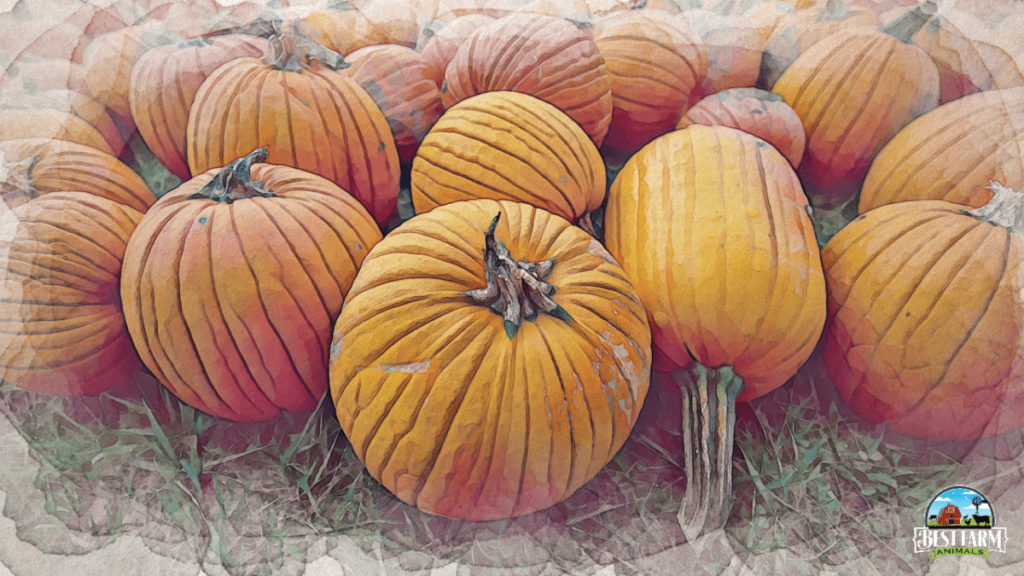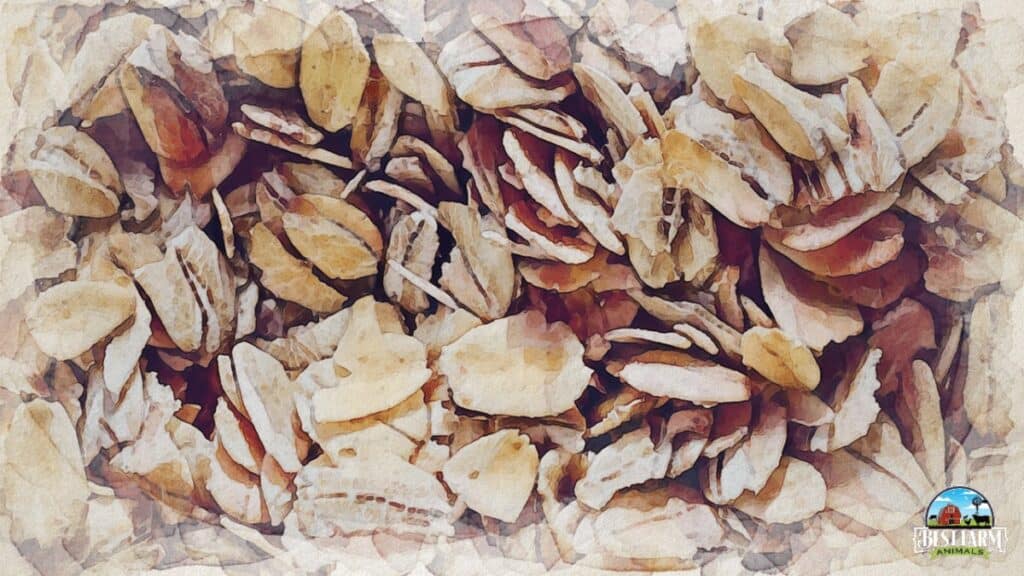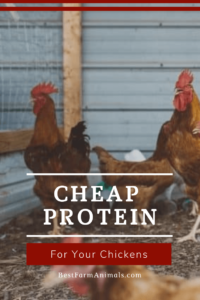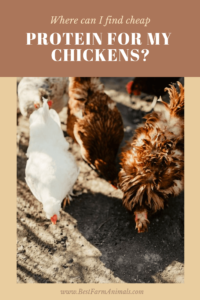One of the biggest factors I considered raising chickens is the cost versus the return of the chickens. Chickens need a constant source of protein to stay healthy and continue laying eggs and that usually means buying chicken feed to supplement their diets. I wanted to find out how to keep chickens healthy with a diet that includes protein, but without spending a lot of money on chicken feed.
What is the cheapest protein for chickens? Bugs and insects, leftovers, cooked eggs, and nuts and seeds are the cheapest protein sources for chicken. Chickens enjoy eating various insects but crickets, mealworms, and maggots are among the favorites. Some of the best protein-rich scraps and leftovers for chickens include meat scraps and fish scraps.
15 Cheap Protein For Your Chickens
You can feed your chicken many low-cost protein options without jeopardizing their health. From tasty and healthy bugs to readily available scraps and even basic yet delectable leftovers, we cover it all. Come along as we learn about innovative approaches to providing protein to chickens.
1. Chickens Will EatBugs and Insects
Chickens will forage for bugs and insects as a source of protein. This is much harder for cooped chickens, but if you move your chicken coop around the yard or allow your chickens to free-range during the day, then you won’t need to supplement their diets as much. Chickens will eat bugs, spiders, insects. They will also catch mice and lizards if the opportunity arises.
Another option is to feed your chickens maggots. Maggots can be purchased or raised to feed your chickens. Some people think they are super gross so make sure you are ok raising these ugly insects.
In the winter, you can harvest bugs by putting a board on the ground. It will warm up the ground more and bugs will crawl under it to stay warm. Flip the board over after a few days and let your ladies feast.
Crickets, roaches, ants, flies, and termites provide a high-quality, cheap protein supply for my chickens. I’ve also seen chickens snack on snails, millipedes, and dead bees that have fallen from plants. All of these insects and bugs are low-cost sources of protein. They also supply essential vitamins and minerals, making them an excellent complement to any chicken’s diet.
- Grasshoppers, crickets, katydids, and locusts
- Larvae such as caterpillar, moths, ants, mealworms, and moths
- House flies, green bottle flies, and soldier flies
- Centipedes and millipedes
- Aphids
- Snails and slugs
- Beetle and beetle larvae
- Waxworms, superworms, earthworms, and phoenix worms
- Bees
- Weevil
In general, chickens will pass on very few bugs or insects. My chickens are inquisitive creatures that will frequently play with ticks they find on animals or those that have fallen off animals rather than eat them right away. However, when chickens are hungry, they won’t hesitate to eat ticks.
Avoid feeding your chickens bedbugs, mites, lice, and fleas. These are parasites that will infect your animals and disrupt their peace. Chickens also dislike odorous insects such as box elder bugs and stink bugs. Also, prevent your chicken from eating blowflies, which can cause flystrike or myiasis in poultry, other animals or even humans.

2. Chickens And Eggs Are Protein Packed
Chicken eggs make a great source of protein for your chickens as long as they are cooked. Sometimes eggs are a little older than you want to cook, but are still safe to eat. These older eggs make a great meal for your flock. Chicken eggs should be cooked so you don’t train your chickens to feast on the eggs you want to hatch or eat.
Chickens can also eat any edible part of the chicken for human consumption. This means they can also eat the innard organs of your Thanksgiving bird.
You can also feed your chickens the leftover egg shells from your breakfast. Shells are high in protein. Eggs have about 91% protein.
3. Meat Scraps Provide Free Protein
Chickens can eat meat scraps, including beef, pork and lamb scraps healthily. They can eat cooked or raw meat. Chickens can be fed bones and other scraps. You can also obtain meat for free from roadkill. Roadkill usually isn’t something you’d want to eat, but it is edible and great for chickens. They aren’t as picky. Meat has approximately 70% protein.
4. Fish Scraps Are High In Protein
Chickens can eat fish and fish eggs. They aren’t picky and can eat junk fish found in canals, leftover fish scraps from your last fishing trip, or canned fish. Tuna and mackerel are other fish options.
If you live in an area where canals are used for farming, then watch the canals in the fall when they are drained. Often small fish are caught and die in the canals when the water goes away. This is a great free place to collect fish for your chickens. The fish can be frozen. Fish have 61-72% protein.
5. Shellfish Leftovers
Fish will eat shrimp, oysters and lobster scraps. The next time you eat out, keep the lobster shell and innards and feed it to your chickens. They eat both raw and cooked meat. Shellfish also have about 60-70% protein.
6. Collect Earthworms For Free Protein
You can collect earthworms to feed your chickens or purchase them. Dried and live earthworms are one of the best sources of proteins for your chickens. The easiest way to gather earthworms is after a rainstorm or when you’ve watered an area as they come above ground for air when it rains.
7. Meal Worms Are Easy Protein to Raise
You can actually raise mealworms and greatly reduce the cost of supplementing your chicken’s diets. Mealworms offer 53% protein. (buy mealworms here on Amazon)
8. Stale Nuts and Seeds Give Protein While Reducing Waste
You can feed your chickens rancid nuts too smelly for human eating as a protein source. Not only will your chickens devour it, but it will keep extra waste out of landfills. Chickens love seeds and nuts of any kind.
Sunflower seeds, walnuts, almonds, and peanuts can all be fed to chickens. Nuts should be unsalted. Larger nuts such as walnuts and almonds should be chopped up for better consumption. Sunflowers have 26% protein. Other nuts are similar. Garden peas have 23% protein.
9. Pumpkins And Pumpkin Seeds Are Easy Protein To Grow
Pumpkins are a great source of protein and they are easy to grow in a garden and cheap to buy in the fall.
Keep the pumpkin seeds from your Halloween jack-o-lantern to feed your chickens. Don’t throw away the wilted pumpkins. Leftover pumpkin is a great source of protein. Pumpkin seeds have about 32% protein.

10. Japanese Millet, Oats, and Grains As A Cheap Source of Protein For Chickens
Japanese millet is a high source of protein. It also provides other necessary vitamins and minerals needed for chicken health.
Oats are a fairly cheap way to supplement a chicken’s protein. They can be cooked or raw, meaning the leftovers from breakfast can be fed to your chickens. Chickens love any grains so old, stale, or moldy bread is another great source of protein for your chickens. Oats have 10-17% protein.
11. Wheat or Bean Sprouts As A Chicken Super Food WIth Protein
Sprouting grains and seeds unlocks many nutrients that aren’t digestible by chickens any other way. Plus sprouts have high protein. You can sprout legumes, bean sprouts, mung beans, peas, and lentils are all chicken favorites. The overripe peas and beans make great chicken feed if you grow a garden. You can grow your own sprouts for cheaper feed. Sprouts have 26-30% protein.
Wheat can be sprouted easily by soaking in a bucket for 24 hours. Drain it, water it daily and in 7 days you will have wheat sprouts. This makes a cheap supplement for your chicken’s diet because a 50lb bag of wheat costs about $9 and will produce 400 lbs of feed for your chickens.
12. Chicken Feed has 26% Protein
Chicken feed is formulated especially for chickens in all stages of life with the specific protein content they need from chicks, to all flock to layer feed. It’s one of the easiest ways to provide protein, but it isn’t the cheapest way to feed your chickens.
To save money on chicken feed- I often soak and ferment the feed to unlock more nutrients and bolster my flock’s immune system.
However, you can purchase it in bulk or order it online for a better price.
13. Can Chickens Eat Cat Food?
Cat food is high in protein, but there is a lot of debate about whether or not cat food is healthy for chickens. Chickens will definitely consume it, but some die-hard chicken breeders claim that cat food isn’t formulated to be the most healthy for the chickens.
14. Greens Are Good Sources of Proteins for Chickens
Kale, lettuce, rocket, and silverbeet are a few garden greens that are simple to grow and that can be beneficial sources of protein for chickens. Mint, oregano, and sage are also wonderful protein-rich herbs that are also simple to grow.
Sage in particular has 11% protein. Another excellent and affordable source of protein is parsley, which is among my chickens’ favorite. But to ensure that my chicken benefit from this veggie throughout the year, I dry it and mix it with chicken feed.
This makes parsley available even the weather doses’t support growing it. 100g of parsley provides 3g of protein, along with numerous other nutrients, according to the USDA.
Is It Cheaper To Make My Own Chicken Feed? Making your own chicken feed is cheaper. You may feed chickens for free by offering them food scraps such as vegetable peels, bread crusts, and ripe fruit. Furthermore, you can use locally sourced ingredients like grains, and legumes to create a balanced diet for your chickens.
Letting chicken graze in your backyard for bugs and grass is a great source of protein and fiber. Chickens can also peck away at weeds, assisting you with garden care. Never give chicken anything harmful, such as avocado pits or skin, which contain the toxic persin.
What Is A Good Source of Protein For Chickens?
The highest sources of protein for your hens include meat scraps, egg shells and eggs, and fish. The highest plant-based protein for your chickens includes oats, millet, sprouts, nuts, pumpkins, and kale.
You can also purchase protein supplements for your chickens. These products include Dried Shrimp (50% protein), Brewers Yeast (40% protein), Larvae (40% protein), Fluffiest Feathers Ever (28% protein). Chicken feed typically has about 16% protein and can be used to provide protein to your chickens.
High Protein Chicken Feed Recipes
Chickens need protein, but they also need other minerals and vitamins usually found in plant sources. Check out these chicken feed combinations to provide your chicken the optimal diet for its health.
Daily Feed: Combine 5 cups of sprouted seeds, 2.5 cups peas, 2.5 cups oats, 2 TBSP sesame seeds, and ½ cups of mealworms. This can be fed daily to your chickens.
Dry Daily Feed: 30% corn seed, 30% wheat, 20% peas, 10% oats, 10% fish meal. You can add kelp to the recipe to add additional protein and variety.
Additional Supplements: Aragonite or feeding limestone adds calcium to chicken diets. Eggshells also do this. Grit helps chickens with digestion. Probiotics help chickens to stay healthy and fight disease. Chickens are prone to illness so this is important.
Protein per cup of grain if fed to chickens table
| Grain | Protein per Cooked Cup | Protein Per 1/2 Cup |
|---|---|---|
| Quinoa | 8 grams | 4 grams |
| Amaranth | 9 grams | 4.5 grams |
| Kamut | 10 grams | 5 grams |
| Teff | 10 grams | 5 grams |
| Farro | 7 grams | 3.5 grams |

Grower Feed For Chicks
The early stages of life are a critical time for young chicks on their way to becoming productive egg-laying hens. To optimize growth and health during this period, you should feed your chickens a starter feed with higher protein content (around 18 22% by weight) until they reach eight weeks old.
At 8+ weeks old, but before they begin laying eggs it’s prudent to switch them over to grower feed instead. Grower feed typically contains slightly less protein (14 18% by weight) but ensures that they still receive all the nutrients necessary for healthy development.
Grains are essential to any chicken’s diet since these provide key nutritional elements like protein necessary for growth. Corn, wheat, barley, oats, and soybean meal are all great options for growing chicks.
Providing chickens with an optimal diet at each stage of their development is crucially important if you hope to raise healthy and productive birds capable of providing years’ worth of reliable egg production.
Cheap Protein To Feed Chickens FAQs
What are the symptoms of too much protein in a chickens diet? One of the greatest risks of feeding your chickens too much protein is that their diet will lack other vital minerals and vitamins. This causes health issues in your chickens and will lead to obesity, gout and liver problems. If your chickens are getting protein in their diet, but their egg production is still slow, it may be a sign that they are getting too much protein.
How much protein should be in my chicken feed? Chick feed, or starter feed, should have at least 20-24% protein to ensure healthy chickens. 7 weeks old chicks up to laying chicks need 14-16% protein. Regular chicken feed should have at least 15-18% protein to keep chickens healthy.
When do chickens need more protein? Baby chicks need a high level of protein to ensure proper growth. Plus, laying chickens need more protein or their egg production will drop and eventually stop. Molting chickens also need additional protein. Molting chickens are growing a new set of feathers and preparing for colder seasons. Feathers consist of 90% protein so it is vital that your chickens get enough protein in the fall season.
What Foods Are Bad For Chickens? Don’t feed your chickens avocados, tomato plants, potato plants, uncooked beans, foxglove, holly, or periwinkle. These foods are toxic to chickens and will cause severe health problems or death.
My Favorite Chicken and Duck Supplies
This list contains affiliate products. Affiliate products do not cost more but helps to support BestFarmAnimals and our goal to provide farm animal owners with accurate and helpful information.
Manna Pro Oyster Shell keeps eggs strong. Before I gave my chickens oyster shell, I had the oddest eggs, many with weak and irregular shells. Now, I don’t have an issue.
Layer Feed by Manna Pro. I like pellets rather than crumbles as my chickens eat them better and less gets wasted or scavenged by rodents. A good layer feed makes the difference in hens laying many more eggs.
My chickens love this mealworm treat, which gives added protein, something that’s great during molting and winter months.
There are many ways to feed and water your chickens. I like this food and water setup the best because it reduces waste, saves me time feeding and watering, and keeps the food fresh longer. Except, in the winter, I use a heated waterer. The only problem is the heated waterers need to be replaced every few years.
I love this chicken veggie hanger. It makes it easy to give your chickens produce from the garden and keep them occupied in the winter with a fresh head of lettuce.
These chicken toys are a hoot! They will help curb bullying and keep your chickens active, especially in the winter when hens tend to get more lethargic.
Conclusion
When you know where to look, you may find a variety of low-cost protein sources for your chickens. Insects and scraps are not only cheap, but they also give the birds with the nutrients they need to flourish. Cooked poultry items and seeds like pumpkin seeds are another good source of inexpensive protein for your hens.
Consider producing your own chicken feed using protein-rich wastes like meat and fish, as well as plant-based options like oats, millet, and kale, to save money. Treat your chicks to these inexpensive, high-protein snacks.




